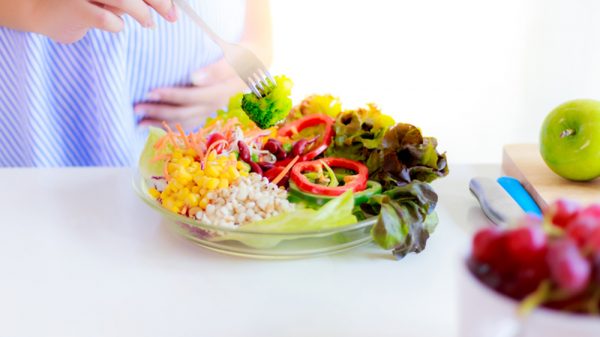If your kids are picky eaters, you know the mealtime struggle that occurs when you try to serve a few shreds of green vegetables. Even though normal picky eating isn’t a cause for concern, as parents we always want to make sure that our kids are getting the nutrients they need for growth and development. Healthy eating for picky eaters can be challenging, but it’s not impossible. If you have a fussy eater at home, try these strategies for encouraging a varied diet and healthy meals for picky eaters.
Tips for Encouraging Your Picky Eater to Try New Foods
Picky eating is a temporary phase that nearly all kids go through at some point during their childhood. Usually, children outgrow picky eating as they get older and get accustomed to more foods. Half the battle is just helping them feel comfortable with the idea of new foods. Here are some tips for helping your picky eater associate new foods with new, positive experiences and to make the process as painless as possible.
1. Introduce Foods Slowly
For a kid who’s finicky with food, a whole plate filled with new foods can be overwhelming. Instead, stick with introducing small portions of new foods over time, at a rate that challenges your child but is also doable. For example, maybe each dinner includes a small bite of new food. If you’re serving green beans as a side dish, set a rule that your child must eat at least one green bean.
2. Start with Fruits Before Vegetables
If you’re struggling to get your child to eat lots of vegetables, try switching to fruit. Many fruits are very sweet and to a child, may taste similar to candy. Make no mistake, though; fruits are extremely nutritious and provide complex carbohydrates for energy, vitamins for immune health, and antioxidants that promote healthy growth and development. Particularly sweet fruits include mango, pineapple, apple, grapes, dates, and bananas. Other good options include raspberries, blueberries, cherries, strawberries, blackberries, oranges, kiwis, and watermelon.
3. Use More Non-Green Vegetables
Sometimes, the color green is enough to deter your child from eating certain veggies. Instead, go for vibrant vegetables that have more appealing colors, like red, orange, and yellow. These more brightly colored vegetables are also easier to disguise in dishes. For example, go for red bell pepper, yellow bell pepper, sweet potato, cauliflower, and beets.
4. Test Different Textures
Sometimes, picky eaters are more sensitive to textures that taste. Are the foods that your child likes generally crunchy, or are they soft? If your child prefers crunchy foods, focus on providing healthy options that also afford a satisfying crunch.
5. Avoid Giving Too Much Attention to the Picky Eater
Sometimes, the picky eaters know that they are getting your attention by refusing to eat certain foods. As a result, they learn that this is an effective tactic for getting and keeping your attention, making it more likely that’ll they will repeat the negative action. Though it’s easier said than done, try to aim cool, calm, and collected when serving a new food. Tell your child your expectation for them to clear the small portion of new food, and then move on to interacting with other children or family members and enjoying a meal. Too often, we as parents tell children to eat something and our attention zeros in on the picky eater as he or she continues to refuse, and we get increasingly frustrated.
6. Get Your Child Involved in Cooking
When kids are involved in the cooking process, they will be more driven to taste what they created. Choose creative recipes for picky eaters that involve making colorful food or using new kitchen equipment. A fun project for kids is pasta-making. Rolling out the dough and using a pasta press is active and creative, and the end product is tasty! Have premade Bolognese sauce on hand, so you can easily prepare pasta Bolognese for an easy and nutritious lunch or dinner.
7. Communicate the Importance of Nutrition
Being vocal about foods that are healthy for growth helps kids understand why they should eat certain foods over others. With increased knowledge about healthy foods, children are encouraged to think more about the foods they eat. Knowledge of nutrition increases open-mindedness towards new foods and supports positive food choices in the future. Shift the rhetoric towards fruits and vegetables as increasing strength, instead of meat and cheese. This will help kids associate fruits and veggies with healthy growth.
8. Create a Positive Mealtime Routine
If mealtime is associated with positive emotions and interactions, it’s likely that your child will be more inclined to try new foods. Perhaps all children in the family can get involved in preparing the table and preparing different parts of a dish for dinner. Or, during each meal, each family member shares the best part of their day and the worst part of their day. Research shows that facilitating positive, supportive social connections during dinner may encourage positive feelings about new foods. (1)
9. Set an Example
If you’re not willing to eat new foods, then your children will be more inclined to mirror that attitude. Make sure that you’re open to trying to foods. Eat a variety of fruits, vegetables, whole grains, and lean meats. Research shows that the more open you are to new foods, the more likely your child is to do the same. (1)
10. Consistent Exposure
For example, don’t just try to serve spinach to your picky eater once every six months. Be consistent with serving spinach and eating spinach, and it will likely normalize the characteristics of spinach, including appearance, smell, and taste. Over time, the idea of eating spinach will become less daunting to your picky eater. Research supports the efficacy of exposing children to new foods on a consistent basis, in order to help them overcome picky eating habits. (1)
11. Make Meals Visualizing Appealing
When choosing healthy recipes for picky eaters, engage the children in food projects that challenge your creativity. Can they make a face out of sliced fruits and veggies? Which food are they choosing for the hair? Which food are they using to make the nose? Feeling involved and creating a project will help them feel accomplished, generating positive feelings towards new foods and helping them become more comfortable with new foods.
12. Volunteer for Soup Kitchens
Volunteering at shelters and soup kitchens, or preparing foods for food drives, will help picky eaters further grasp the importance of food and nutrition. Being involved in a process that prepares and serves food to others in need helps children gain an appreciation for food as fuel. And of course, getting children involved in acts of giving and volunteering is good for their growth and development.
13. Exposure to New Cuisines and Cultures
Broaden your picky eater’s food horizons by helping them learn about staple foods and flavors from other cuisines. You could even hang up a map in the kitchen and color in countries from which you have prepared a recipe. Research recipes together read about the cultural background and flavors, and prepare the food together. Putting new foods and flavors in the context of a culture and country can expand your child’s understanding of food and capture their interest.
If you have friends from another country or you travel to another country, encourage your child to try the foods and be open to new tastes.
For example, when preparing tacos or quesadillas, research the authentic spices used to prepare them. As you’re preparing them with your child, explain why you’re using certain spices to season the meat and vegetables.
14. Run a Family Version of “Chopped”
Using the television show as inspiration, challenge your kids to prepare a dish using the ingredients you’ve assembled for them. This is a fun challenge for kids and allows them to express themselves while having fun and becoming familiar with ingredients. Encourage your picky eater to taste the foods they’re combining, since chefs must always taste the food that they’re preparing for others! Allow the kids to choose ingredients for you to make a meal. Kids will love to watch you take on the challenge they’ve set up for you. Plus, when you prepare the meal, they will need to taste it to judge it! This is an excellent way for picky eaters to enjoy trying new foods in a fun environment.
Healthy Meals for Picky Eaters
While you’re employing the above strategies, it’s helpful to have healthy meal ideas on hand to prepare for picky eaters. And when your a parent, one of your priorities is making sure you’re kids get the nutrients they need. One of the most effective ways to help picky eaters get the nutrients they need is by incorporating healthy foods into tasty meals. Many of the meals below put a healthy spin on kids’ classic favorites or disguise healthy foods in seemingly unhealthy meals. Even the pickiest of eaters won’t be able to resist. Whether you’re preparing breakfast, lunch, dinner, or snack – we got you covered!
Breakfast Ideas for Picky Eaters
Breakfast can be the most difficult meal for parents of picky eaters. Between getting ready for work, getting the kids ready for school, feeding the dog, and making sure the kids make the bus on time, we’re often relieved if the kids will eat anything for fuel. The key to a nutritious breakfast for picky eaters is making it quick, easy, and tasty.
1. Breakfast Sandwich
A healthy version of a breakfast sandwich can be whipped up in no time. Toast a whole-grain English muffin and top with cooked egg whites for protein and low-fat cheese. Season with a little salt and pepper. For extra nutritional value, try adding a thin layer of mashed avocado to the English muffin as a substitute for butter. Avoid processed meats on breakfast sandwiches, since breakfast sausages tend to be very high in saturated fat and preservatives.
2. Yogurt Parfait
You can layer healthy ingredients to make a yogurt parfait in just minutes. First, start with a layer of nonfat, low-sugar Greek yogurt. Then, add a layer of your child’s favorite fruit, such as blueberries, banana slices, blackberries, or raspberries. Sprinkle with low-sugar granola. Again, layer Greek yogurt, fruit, and granola. Drizzle with honey. To make it visually appealing, layer ingredients in a clear glass. This breakfast provides a punch of protein from Greek yogurt, antioxidants and vitamins from fruit, and carbs from granola. Be sure to choose a granola that contains no added sugar and is minimally processed. You can also make delicious and nutritious homemade granola.
3. Pancakes
Pancakes are notoriously time consuming and unhealthy. Traditionally, pancakes are exactly what the name describes – cake. However, you can make pancakes using flour substitutes like almond flour. Use nutritious and high-protein binders like eggs and flaxseeds. Flavor with ripe banana and pumpkin, and season with cinnamon for pancakes rich in carotenoids that have antioxidant activity. Make a big batch of pancakes at the beginning of the week to get ready for the school week ahead. Store them in the refrigerator and heat them up in the microwave in the morning. Serve with fruit and a drizzle of agave nectar for a low glycemic sweetener.
School Lunch Ideas for Picky Eaters
Preparing lunch is one thing, but what about a healthy, portable lunch that a picky eater will actually eat while at school?
1. DIY Mini Pitas
Kids love anything they can assemble on their own and having DIY lunches can be one way to persuade picky eaters to try new foods. In a small container with dividers, pack brown rice, shredded low-fat cheese, shredded lettuce, and ground turkey meat. You can prepare meat for pitas using a slow cooker to make seasoned shredded chicken. Serve with mini pitas.
Mini pitas are versatile and can be filled with any sandwich filling that your child enjoys. Provide a utensil so kids can easily pour ingredients into pita pockets and eat.
Though prepared lunch meat is often a go-to meat for school lunches, it is high in unhealthy preservatives, sodium, and often high in fat. If you include meat in your child’s lunch, choose meat that you’ve prepared at home. Just ensure that there’s a reliable way to keep it cool until lunch.
2. Peanut Butter Sandwich
There’s nothing wrong with this timeless classic! A peanut butter and jelly sandwich provides lots of nutrients for a growing child. To make a peanut butter and jelly sandwich nutritious, it all comes down to choosing the right ingredients. Choose a peanut butter that has no other ingredients except for peanuts. Choose a jelly or jam with no added sugar or preservatives and stick to whole grain bread. This provides your child with high-quality protein and fiber.
3. Mini Pizzas
Mini pizzas make the perfect lunch for picky eaters. Prepare mini pizzas ahead of time using whole-grain bagels or whole-grain pizza dough. Top with low-sugar tomato sauce, low-fat cheese, and any vegetables that your child likes. Try grilled onions, banana peppers, and green peppers. Before baking the pizza, you can add a layer of chopped spinach and cauliflower before covering with tomato sauce and cheese to sneak in extra vegetables.
4. Leftovers
Lunches don’t need to be conventional. If your picky eater loved veggie-packed spaghetti Bolognese (see recipe below), why not pack it for school lunch the next day, too? As long as they enjoy nutritious food and you can store it effectively, leftovers are a great option for school lunches.
Dinner Ideas for Picky Eaters
These dinner ideas pack nutrients into traditional comfort meals that picky eaters enjoy. Plus, they’re family-friendly and provide excellent ways to provide a filling, nutritious weeknight meal.
1. Spaghetti Bolognese
Spaghetti Bolognese is a versatile dish that welcomes the addition of ground veggies. Make a healthier version of Bolognese sauce to make sure your kids are getting the nutrients they need. Instead of ground beef, aim for a naturally low-fat, high-quality white meat like ground turkey. Cook in a pan with sautéed onions and garlic. When cooked, add a jar of low-sugar tomato sauce and stir. In a separate pan, combine grated carrots, beets, and red pepper. Any red or orange vegetables will work since they will blend in with the tomato sauce. Your child won’t even know that their spaghetti Bolognese is packed with veggies! Sauté until soft and add to the tomato sauce.
Serve the spaghetti Bolognese over whole-grain pasta, or a blend between whole-grain and white pasta. Top with parmesan cheese and serve.
As an alternative to Bolognese sauce, prepare turkey meatballs to serve with spaghetti and tomato sauce.
2. Macaroni and Cheese Casserole
Good old mac n’ cheese is beloved by nearly every child, picky eaters especially. The macaroni and cheese casserole is a new take on classic macaroni and cheese and provides an easy way to hide vegetables. Plus, casseroles are large, and depending on how many people are in your family, you may have dinner for two nights. The key to making a healthy macaroni and cheese is to use a cheese that is low in fat and sodium while baking lots of yellow and white vegetables into the casserole. Start out by preparing macaroni noodles, or your child’s favorite pasta shape. Shells work great for this casserole as well. Boil the pasta until al dente, or slightly undercooked, since the pasta will finish cooking in the oven. Stir low-fat cheddar cheese and nonfat mozzarella cheese into the cooked pasta. To make the mac and cheese a little creamier without extra saturated fat, stir in cashew cream or nonfat Greek yogurt. In a separate pan, add grated or shredded cauliflower, butternut squash, and parsnips, and cook until soft. Fold into the macaroni and cheese and pour into a casserole dish. Top with shredded cheese and bread crumbs and bake until crisp.
3. Chicken Nuggets
What child doesn’t like chicken nuggets? Instead of grabbing nuggets from a fast-food restaurant on the way home from soccer practice, try making a healthy version at home. Your picky eater won’t even know the difference. Cut strips of chicken breast into bite-size pieces. Instead of breading with traditional white flour, try using a combination of almond meal, cornmeal, and ground flaxseed. To give the chicken nuggets a crispy texture, use an air fryer, which can be used in a variety of recipes to make healthy versions of your favorite fried foods. Serve with low-sugar ketchup. Sweet potato fries make a healthy complement to chicken nuggets, affording lots of fiber, potassium, vitamin C, and carotenoids with antioxidant activity.
4. Cheeseburger and Fries
A cheeseburger and fries don’t have to be unhealthy. Prepare a burger using ground turkey meat, instead of fatty ground beef. Top with a slice of low-fat cheese and serve on a whole-grain bun. To prepare French fries, slice up whole white potatoes into wedges, without removing the skin. Potato skin is rich in fiber and vitamins and enhances the nutritional value of French fries. Lightly coat in olive oil, salt, and pepper, and bake in the oven until browned. Alternatively, toss the potato wedges in the air fryer. Though a meal of cheeseburger and fries isn’t packed with vegetables, this version of the traditionally unhealthy meal provides higher quality protein and more nutrients.
5. Tacos and Quesadillas
Tacos make a perfect dinner for the picky eaters in your family. To create a high-protein, high-fiber filling, combine lean ground beef and black beans. Cook thoroughly and mash the black beans together with the beef. Add in finely chopped bell pepper, onion, spinach, and garlic and thoroughly mix. Season with a can of tomato paste and your favorite taco seasoning. Layer the meat and vegetable mixture into soft taco shells, cover in low-fat cheese, and roll. By rolling the tacos, your picky eater won’t be able to pick up any visual discrepancies between plain taco filling and the meat and vegetable mixture.
As an alternative, use the same filling to spread onto a whole-grain tortilla. Sprinkle with low-fat cheese and cover with a second whole-grain tortilla. Heat until cheese is melted and tortilla is slightly browned.
6. Grilled Cheese
Much like tacos and quesadillas, grilled cheese sandwiches provide a sneaky way to incorporate extra, healthy ingredients. Grill cauliflower, chop into small pieces and sprinkle on grilled cheese for extra nutrients.
7. Lasagna
Lasagna provides yet another opportunity to hide vegetables into a mixture of ground meat, cheese, and pasta. To create the lasagna filling, start out with low-fat ground meat and season with tomato paste, basil, and oregano. Then, get creative with the vegetables. Add grated zucchini, carrot, and sweet potato to the ground meat and mix until thoroughly blended. Mashed chickpeas also work well as a high fiber addition to ground meat. Many vegetables and beans are able to take on the flavor of whatever dish they are in and usually blend seamlessly with ground meats. Layer your lasagna noodles with your meat and vegetable filling, tomato sauce, and ricotta cheese.
8. Nachos
Nachos are an irresistible meal for picky eaters. As the base, use a combination of whole-grain corn chips and homemade sweet potato chips. Layer with lean ground beef, black beans, salsa, guacamole, and melted cheese.
Snacks for Picky Eaters
A picky eater’s favorite snacks usually include something salty and crunchy or smooth and sweet, like potato chips, pretzels, candy, French fries, and milkshakes.
1. Popcorn
Popcorn is a perfect snack for a picky eater. It has a satisfying crunch while providing the benefits of whole grains, like fiber and complex carbs. Avoid using microwaveable bags of popcorn and bagged popcorn, which often contains too much butter, salt, and preservatives. Instead, make a healthy batch of popcorn on the stovetop. Simply heat up a tablespoon of olive oil in a large pot and turn the pot to make sure the bottom is coated with oil. Add popcorn kernels to the pot in a single layer. Cover with a lid and keep the heat on high. As soon as you hear the first kernels popping, rotate the pot on the stovetop to ensure that heat is distributed equally and to prevent the burning of kernels. All kernels should be popped in just a few minutes! Season with salt, pepper, and a drizzle of olive oil.
2. Smoothies
Smoothies are easy, healthy substitutes for milkshakes. You can prepare a variety of smoothie flavors to suit your child’s taste. Try combining ripened frozen bananas, frozen strawberries, low-sugar soymilk, and pitted dates in a blender for a smoothie that has the sweetness and consistency of a shake. Want the smoothie to have a bright pink hue? Throw in frozen beets or a packet of frozen açaí berries. It’ll enhance the visual appeal and the nutritional value, and your picky eater won’t taste the difference!
For a chocolate shake, replace the frozen strawberries with more frozen bananas and add a spoonful of cacao powder and a tablespoon of peanut butter. You can even increase the protein and fiber content without changing the taste of these healthy shakes. Simply add a high-quality essential amino acid supplement, which provides all of the essential amino acids your child needs for growth and development. For extra fiber and antioxidants, add 2 tablespoons of ground flaxseeds.
3. Strawberries and Chocolate
This snack tastes like a dessert while also including all of the polyphenols, fiber, and vitamins present in strawberries and chocolate! To prepare, melt dark chocolate chips in a pot with a little bit of skim milk. Be sure to use dark chocolate since it is lower in sugar and packed with more antioxidants. Serve with fresh strawberries.
4. Hummus and Carrots
The fun of dipping foods into sauces can make certain snacks more appealing to the picky eater. Hummus is a high-protein, high-fiber dip that can be served with sliced carrots, celery, and bell peppers. Cucumbers, broccoli, cherry tomatoes, cauliflower, crackers, and corn chips pair well with hummus dip too.
5. Muffins and Cookies
Your picky eater is likely a fan of common dessert foods, like muffins, cookies, and cake. These baked goods are usually very unhealthy when bought premade. However, when prepared at home, smart substitutions can turn an unhealthy dessert into a nutritious snack that will be irresistible to fussy eaters.
- Flaxseeds: Ground flaxseed can be used as a binder in many recipes, as a substitute for eggs. Flax also provides anti-inflammatory lignans, fiber, and protein.
- Essential amino acid supplements: A high-quality essential amino acid supplement can be added to baked goods to enhance the nutritional value. Getting essential amino acids in optimal ratios is ideal for promoting muscle synthesis, growth, and neurological health.
- Flour substitutes: White flour is highly processed and stripped of nutritional value. Consuming too many white flour products is hard on the liver, spikes blood sugar, and contributes to weight gain. Swap out white flour for a combination of whole grain flour and nut meals, like almond flour, chickpea flour, and hazelnut meal.
- Dates and ripe bananas: Both dates and overripe bananas are excellent sweeteners without the negative impacts of processed sugars.
- Avocado and coconut: Many recipes call for products high in saturated fat, like butter and cream. Consuming too much-saturated fat from animal products can over time lead to high cholesterol levels. Avocados and coconut cream provide the creaminess needed for baking recipes, plus fiber, healthy fats, vitamins, and minerals. Though the fat in coconut milk and coconut cream is saturated fat, it is a different type of saturated fat than that found in animal products.
- Natural food coloring: Ditch the artificial coloring and natural coloring instead! Beet juice gives baked goods a pink color, without artificial dyes. For green hues, try pureed spinach. Acai gives baked goods a purple color, while blueberries create a blue hue. For a vibrant gold color, add turmeric to your baked goods. Plus, vibrantly colored foods and spices are naturally rich in antioxidants that support immune system health and efficient healing.
Adjust Recipes as You Need
The above meal ideas for picky eaters can be easily adjusted to accommodate food sensitivities and allergies. For example, if your child has a gluten allergy, substitute breads and pastas with gluten-free and grain-less versions available grocery stores.
As you prepare healthy alternatives for picky eaters, you’ll be able to monitor what foods your child prefers. Experiment with different vegetables and see which vegetables your child tends to gravitate towards.
Conclusion
Picky eating is common among children, making it tough for parents to figure out what to prepare. However, using strategies for sneaking healthy foods, familiarizing your child with varied foods, and involving your child in the food preparation process can help picky eaters become more open to trying new foods. And thankfully, children tend to naturally outgrow picky eating with age.
References:
(1) https://www.ncbi.nlm.nih.gov/pubmed/30392488
























